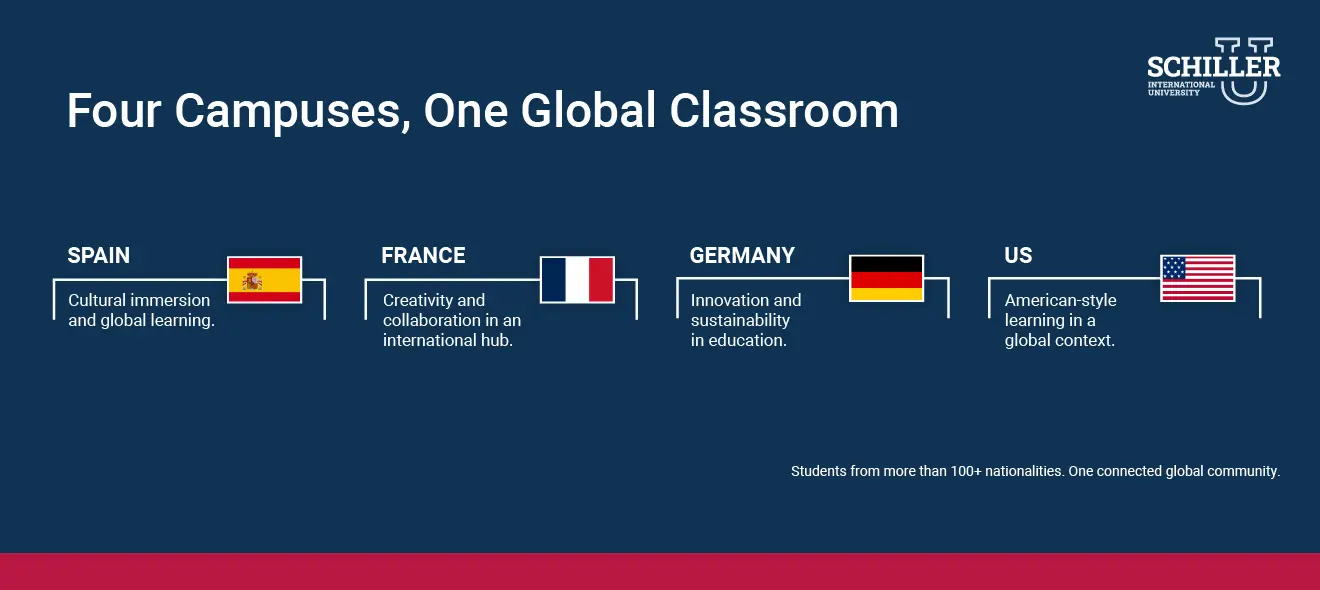On any given day at Schiller International University, you might hear Spanish, Arabic, French, and Hindi spoken in the same hallway. A student might share a traditional lunch from their home country while discussing a group project with classmates from three continents. These ordinary moments carry extraordinary lessons. They represent the daily rhythm and the benefits of multicultural education. It is learning shaped by people, stories, and perspectives that stretch far beyond national borders.
Multicultural education is the practice of learning through diversity. It invites students from different backgrounds to study, question, and grow together. It is an environment that values every voice and teaches how understanding one another can expand what we know of the world and ourselves.
Importance of Multicultural Education
To study in a multicultural environment is to experience constant dialogue. You will encounter worldviews that may surprise, challenge, or move you. You will also learn that culture is not an abstract idea; it lives on in gestures, communication styles, and shared values. Through collaboration, you can build the patience to listen and the confidence to speak with respect.
This is what makes multicultural education essential. It goes beyond coexistence. It builds connections. It will prepare you to live and work with empathy. You will become culturally aware and enhance your adaptability skills. These are not soft skills but survival skills if you want to build a global career.
Benefits of multicultural education
The importance of multicultural education lies not only in what students study, but in how they grow as they listen, question, and learn from one another. The benefits of multicultural education unfold in ways both practical and deeply personal, shaping how individuals think, communicate, and lead in an interconnected world.
1. Broader Worldview and Global Awareness
The first benefit of multicultural education is perspective. Exposure to diverse traditions, histories, and social realities deepens the understanding of the human experience. You will learn that there are many ways to approach a problem or tell a story. Your classroom will become a small version of the world, where you can share ideas freely with your peers and teachers.
This kind of learning nurtures cultural awareness in the classroom. It will help you see thought patterns shaped by history and geography and build respect for difference. Over time, you will develop a global mindset, one that values curiosity and compassion as much as knowledge.
2. Communication and Collaboration Across Cultures
In a multicultural learning environment, communication is more than the exchange of words. It requires attention, interpretation, and trust. You will learn to collaborate with peers who think and express themselves differently in different circumstances. You will also learn to recognize silence, tone, and nuance.
These lessons will prepare you for the realities of international collaboration. Whether managing a team across time zones or working on a cross-border project, graduates who have learned to communicate across cultures bring clarity and understanding wherever they go. This skill is central to global education benefits and remains one of the strongest advantages of multiculturalism in education.
3. Better Preparation for Global Careers
Employers today seek professionals who can read context, not just data. Graduates who have experienced diversity in education carry an instinct for adaptability. They can walk into a room in Berlin, Dubai, or São Paulo and find common ground.
Multicultural education develops this readiness. You will learn cultural competency in education which translates into sensitivity in the workplace. You will also master the art of balancing differing expectations, communicating effectively, and navigating the unspoken codes of global interaction. This understanding will help your professional growth and help you become a responsible global citizen.
4. Innovation and Creativity Through Diversity
When people with different worldviews come together, new ways of thinking emerge. In a multicultural classroom, creativity thrives on contrast. Students challenge one another’s assumptions and combine ideas in ways that a single cultural setting rarely allows.
A project on sustainability might bring together a student from Germany focused on engineering efficiency, a student from India with insight into resource constraints, and a student from Spain inspired by local innovation. Their solutions reflect the strength of the collective imagination. You will learn why diversity, in this sense, is a source of creativity and one of the lasting advantages of multicultural education.
5. Building Inclusive and Respectful Communities
Learning with people from different backgrounds can be humbling. It can also be uncomfortable. The first months in a multicultural classroom often bring cultural shocks. You may question your habits or discover how deeply your upbringing shapes your reactions. Yet through these moments, you will learn tolerance, empathy, and inclusion.
Inclusive education benefits everyone. It creates a space where disagreement is not division, and respect is practiced daily. You will learn to speak without judgment, to listen without assumption, and to find unity in differences. The process will help you form a sense of belonging that transcends nationality or language.
How Schiller Embodies Multicultural Learning

Schiller International University is a living model of multicultural education. With campuses in Spain, France, Germany, and the United States, it offers American-style education in a truly global setting. Students come from more than 130 nationalities, each bringing a piece of their world into the classroom.
Our intercampus mobility program allows learners to move between countries, experience different academic cultures, and adapt to new environments. This mobility will help you strengthen your resilience and cross-cultural understanding. Every course, discussion, and project reflect Schiller’s belief that education should prepare students to engage in a complex and interconnected world.
At Schiller, the international classroom experience is not a concept but a daily practice. We nurture global citizenship and cultural empathy to help our students grow into professionals who think critically, communicate clearly, and act with a sense of shared humanity.
Building Global Citizens Through Education
The benefits of multicultural education reach far beyond graduation. They shape how people live, work, and relate to others throughout their lives. In learning to appreciate diversity, you will learn how to lead. In learning to listen, you will learn the importance of building communities that value fairness and understanding.
Education that welcomes many cultures teaches us how to find balance in differences. It teaches us that respect is the foundation of collaboration, and curiosity is the beginning of empathy. Schiller International University continues to embody this belief, creating a global student community that learns beyond borders and carries those lessons into every corner of the world.
Explore our global campuses in Madrid, Paris, Heidelberg, and Tampa to experience the advantages of multicultural education.
FAQs
Q1. What is multicultural education and why is it important?
Answer: It is an approach to learning that includes perspectives, histories, and values from multiple cultures. Multicultural education is important because it encourages understanding, equality, and cooperation, helping students build empathy and awareness.
Q2. How does multicultural education prepare students for global careers?
Answer: It helps in building communication skills, learning how to adapt to different circumstances, and developing cultural competency. These qualities will help you thrive in international organizations and multicultural teams.
Q3. What are the key benefits of studying in a multicultural environment?
Answer: By studying in a multicultural environment, you will gain a broader worldview, improve your collaboration and problem-solving skills, develop empathy, and become a more creative and open-minded global citizen.
Q4. How do universities promote cultural diversity and inclusion?
Answer: At Schiller, we design programs that bring students from various backgrounds together. Our multicultural campuses around the world encourage intercultural learning and create safe spaces for dialogue and collaboration.
Q5. What makes Schiller International University a great example of multicultural education?
Answer: Schiller brings students from over 130 nationalities together across four global campuses in Spain, France, Germany, and the US. We offer an inclusive, multicultural international education that promotes understanding, adaptability, and global citizenship.

 Request information
Request information









